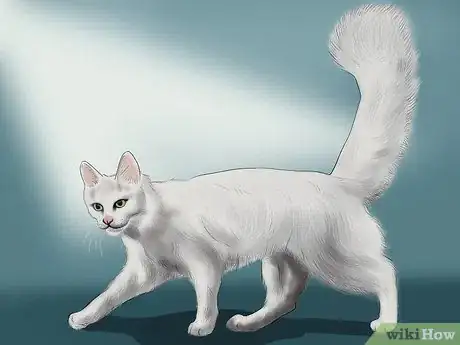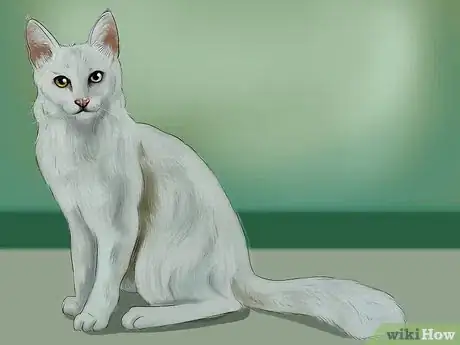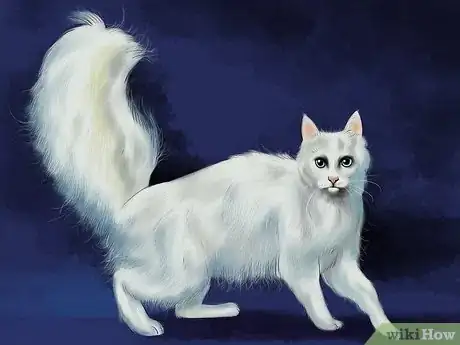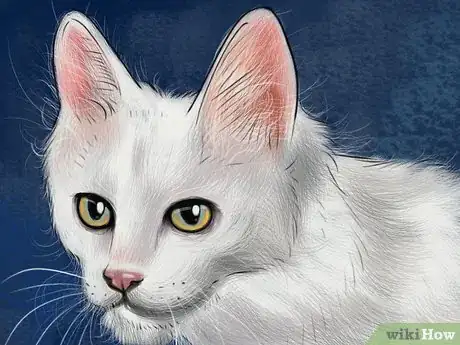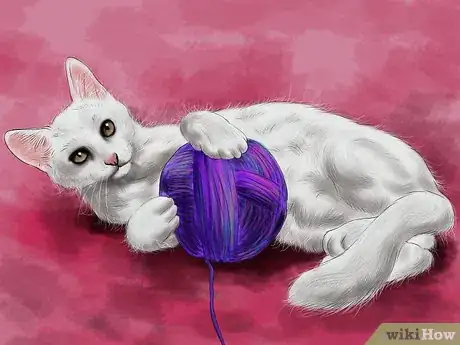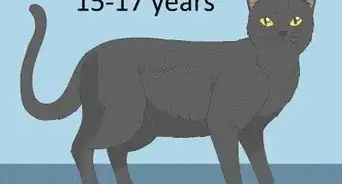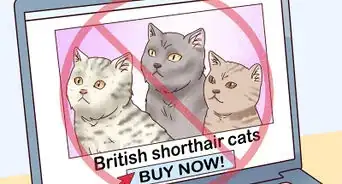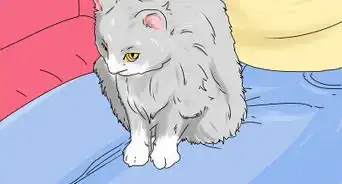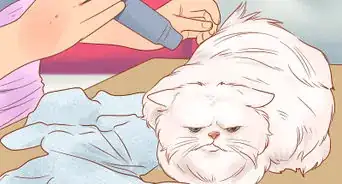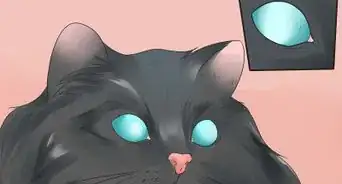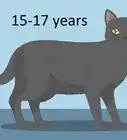This article was co-authored by Lauren Baker, DVM, PhD. Dr. Lauren Baker is a Veterinarian and Assistant Scientist at the University of Wisconsin-Madison. With over 10 years in veterinary medicine, she specializes in the concept of “one health,” which uses insights from veterinary medicine to help human medical research. She holds a Ph.D. in Comparative Biomedical Sciences, a Doctor of Veterinary Medicine, an MS in Comparative Biomedical Sciences, and a Bachelor’s degree in Psychology from the University of Wisconsin-Madison.
There are 9 references cited in this article, which can be found at the bottom of the page.
This article has been viewed 73,575 times.
The Turkish Angora is a natural breed that comes from the region of Ankara (formerly called Angora) in Turkey.[1] The first mention of this breed dates to the 15th century.[2] To identify this breed, look for the long, silky coat, an elegant, delicate body, and an alpha personality. If you’re interested in getting a Turkish Angora, check with a reputable breeder or rescue.
Steps
Identifying Physical Characteristics
-
1Look for a long, silky coat. Turkish Angoras are known for their beautiful, shimmery, silky coats. Their coat is long, though it will be shorter during the summer. During the winter, the hair grows much longer, especially around the mane and legs. The tail is plumed.[3]
- The breed is single-coated and has no undercoat.
-
2Look for a variety of coat colors. The most common color for a Turkish Angora is white. However, breeders have started trying for other colors. They can also come in blue, black, red, and cream, along with tortoiseshell, blue-cream, mackerel tabby, spotted tabby, or bi-colors.[4]
- This breed can pretty much come in any shade or pattern. However, colors that point to any hybridization, like lavender, chocolate, or pointed patterns, are not accepted for this breed.
Advertisement -
3Check for delicate features. Turkish Angoras have very slim, long, elegant features. The limbs are graceful, and the build is slim. Some consider the Angora dainty because of its small, fine bones and narrow chest.[5]
-
4See if the cat’s build is small. In addition to having delicate features, Turkish Angoras tend to be on the small side. They may be small to medium-sized, ranging in weight from 5 to 9 pounds (2-4 kg).[6]
-
5Notice the shape of the physical features. Turkish Angoras have wedge-shaped heads that taper near the chin. They have tall, pointed ears, and long, slender necks and torsos.[7] Their eyes are large and almond-shaped. The eyes come in multiple colors, including blue, green, and amber.[8]
- Some Turkish Angoras have two different colored eyes, one of which is usually blue.
Recognizing Behavior Characteristics
-
1Expect an outgoing, social cat with alpha tendencies. Turkish Angoras are active cats who love to be around others. They don’t like to entertain themselves and expect their owners to interact with them often. They get bored easily if they don’t get as much attention as they want. They like to take charge and rule everyone around them.[9]
- Turkish Angoras usually do well with families and other pets. This breed will take the alpha role when around other cats and dogs.
- The breed does well with visitors.
-
2Notice an independent streak. Turkish Angoras are independent cats who like to do things on their own. They will sometimes “talk” to you to give their opinion on how you should do something.[10]
- These cats bond with their humans and love spending time with them. They generally stay in the same room with you, watching and supervising.
- They are stubborn cats who can easily get into bad habits because of their independent streak. However, they are intelligent and can learn tricks and commands.
-
3Check if they like to swim. Like the closely-related Turkish Van, many Turkish Angoras enjoy water more than the average cat. A Turkish Angora may enjoy playing in water or taking an occasional swim, and might even try to join you in the shower or bath![11]
-
4Look for a cat that loves to run and play. Turkish Angoras love to dance around and play with toys. They have a strong hunting instinct, so they will pounce on fake mice and birds, and even their owner’s feet. They like to run around, especially if they are chasing toys.[12]
- Turkish Angoras also love to climb.
Finding a Turkish Angora
-
1Find a breeder. If you want to adopt a Turkish Angora from a breeder, locate a reputable breeder. Turkish Angoras are a rare natural breed. Prices for a pet Turkish Angora range from around $150 to $400 USD. If you want a cat that is show worthy, they range from $700 to over $1000 USD. White Angoras with blue eyes are the rarest and most expensive.[13]
- You can generally get a kitten from a breeder when they are between 12 and 16 weeks old.[14]
- An ethical breeder will provide health certifications that show they have screened for genetic health problems. They will raise kittens at home and will socialize them early.[15]
- Start by checking cat breed websites, such as The Cat Fanciers’ Association, The Fanciers Breeder Referral List, Cat’s Center Stage, and The International Cat Association.
- If you visit breeder websites, watch for red flags. These include immediately available kittens, multiple litters, paying online with a credit card, options for shipping kittens, and your choice of any kitten.
-
2Try adoption. Instead of going to a breeder, consider adopting a Turkish Angora. They are relatively rare, but you can check local shelters and pet adoption websites. Petfinder and Adopt-a-Pet may provide you with listings for Turkish Angoras for sale.[16]
- Talk to your vet or local breeders about whether they know of any Turkish Angoras that need rescuing.
-
3Be patient. Finding a Turkish Angora may take a while, since they are an uncommon breed. If you are interested in getting a cat from a breeder, be aware that since they are rare, the wait time may be a while. You may be able to find a breeder who will have a litter soon, but remember you will have to wait up to 16 weeks before you get your kitten.[17]
Expert Q&A
Did you know you can get expert answers for this article?
Unlock expert answers by supporting wikiHow
-
QuestionA cat turned up at my mum's and decided that was where she was going to live. I think she's a Turkish Angora, but how would I know for sure?
 Lauren Baker, DVM, PhDDr. Lauren Baker is a Veterinarian and Assistant Scientist at the University of Wisconsin-Madison. With over 10 years in veterinary medicine, she specializes in the concept of “one health,” which uses insights from veterinary medicine to help human medical research. She holds a Ph.D. in Comparative Biomedical Sciences, a Doctor of Veterinary Medicine, an MS in Comparative Biomedical Sciences, and a Bachelor’s degree in Psychology from the University of Wisconsin-Madison.
Lauren Baker, DVM, PhDDr. Lauren Baker is a Veterinarian and Assistant Scientist at the University of Wisconsin-Madison. With over 10 years in veterinary medicine, she specializes in the concept of “one health,” which uses insights from veterinary medicine to help human medical research. She holds a Ph.D. in Comparative Biomedical Sciences, a Doctor of Veterinary Medicine, an MS in Comparative Biomedical Sciences, and a Bachelor’s degree in Psychology from the University of Wisconsin-Madison.
Veterinarian
References
- ↑ http://cattime.com/cat-breeds/turkish-angora-cats#/slide/1
- ↑ http://www.vetstreet.com/cats/turkish-angora#overview
- ↑ http://www.petmd.com/cat/breeds/c_ct_turkish_angora
- ↑ http://www.petmd.com/cat/breeds/c_ct_turkish_angora
- ↑ http://www.petmd.com/cat/breeds/c_ct_turkish_angora
- ↑ http://cattime.com/cat-breeds/turkish-angora-cats#/slide/1
- ↑ http://cats.animal-world.com/Natural-Breeds/TurkishAngoraCat.php
- ↑ http://www.hillspet.com/en/us/cat-breeds/turkish-angora
- ↑ https://cfa.org/turkish-angora/
- ↑ http://www.vetstreet.com/cats/turkish-angora#personality
- ↑ http://www.vetstreet.com/cats/turkish-angora#overview
- ↑ http://www.vetstreet.com/cats/turkish-angora#personality
- ↑ http://cats.animal-world.com/Natural-Breeds/TurkishAngoraCat.php
- ↑ https://cfa.org/turkish-angora/
- ↑ http://www.vetstreet.com/cats/himalayan#finding
- ↑ http://www.vetstreet.com/cats/turkish-angora#finding
- ↑ http://www.vetstreet.com/cats/turkish-angora#finding
About This Article
To identify a Turkish Angora, look for a white cat with a long, silky coat. Also, look for a wedge-shaped head, tall and pointy ears, and a long neck and torso. You should also examine the cat's build and features, which will be small and delicate if it's a Turkish Angora. Also, note the shape and size of the cat's eyes since Turkish Angoras are known for their large, almond-shaped eyes. For more tips from our Veterinary co-author, like how to identify a Turkish Angora based on its personality, scroll down!
